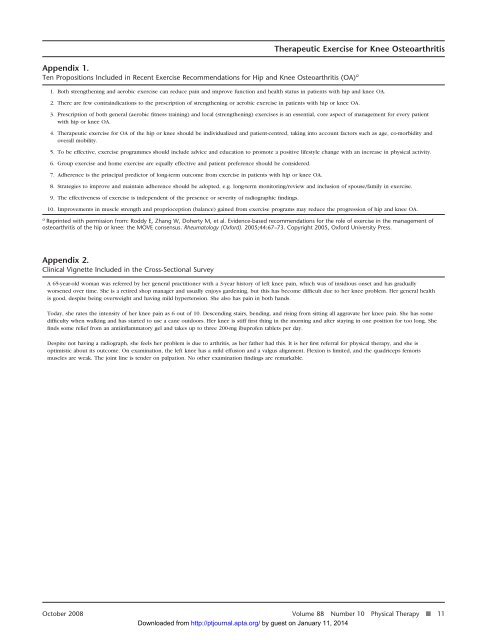Physical Therapists' Use of Therapeutic Exercise for Patients With ...
Physical Therapists' Use of Therapeutic Exercise for Patients With ...
Physical Therapists' Use of Therapeutic Exercise for Patients With ...
You also want an ePaper? Increase the reach of your titles
YUMPU automatically turns print PDFs into web optimized ePapers that Google loves.
<strong>Therapeutic</strong> <strong>Exercise</strong> <strong>for</strong> Knee Osteoarthritis<br />
Appendix 1.<br />
Ten Propositions Included in Recent <strong>Exercise</strong> Recommendations <strong>for</strong> Hip and Knee Osteoarthritis (OA) a<br />
1. Both strengthening and aerobic exercise can reduce pain and improve function and health status in patients with hip and knee OA.<br />
2. There are few contraindications to the prescription <strong>of</strong> strengthening or aerobic exercise in patients with hip or knee OA.<br />
3. Prescription <strong>of</strong> both general (aerobic fitness training) and local (strengthening) exercises is an essential, core aspect <strong>of</strong> management <strong>for</strong> every patient<br />
with hip or knee OA.<br />
4. <strong>Therapeutic</strong> exercise <strong>for</strong> OA <strong>of</strong> the hip or knee should be individualized and patient-centred, taking into account factors such as age, co-morbidity and<br />
overall mobility.<br />
5. To be effective, exercise programmes should include advice and education to promote a positive lifestyle change with an increase in physical activity.<br />
6. Group exercise and home exercise are equally effective and patient preference should be considered.<br />
7. Adherence is the principal predictor <strong>of</strong> long-term outcome from exercise in patients with hip or knee OA.<br />
8. Strategies to improve and maintain adherence should be adopted, e.g. long-term monitoring/review and inclusion <strong>of</strong> spouse/family in exercise.<br />
9. The effectiveness <strong>of</strong> exercise is independent <strong>of</strong> the presence or severity <strong>of</strong> radiographic findings.<br />
10. Improvements in muscle strength and proprioception (balance) gained from exercise programs may reduce the progression <strong>of</strong> hip and knee OA.<br />
a Reprinted with permission from: Roddy E, Zhang W, Doherty M, et al. Evidence-based recommendations <strong>for</strong> the role <strong>of</strong> exercise in the management <strong>of</strong><br />
osteoarthritis <strong>of</strong> the hip or knee: the MOVE consensus. Rheumatology (Ox<strong>for</strong>d). 2005;44:67–73. Copyright 2005, Ox<strong>for</strong>d University Press.<br />
Appendix 2.<br />
Clinical Vignette Included in the Cross-Sectional Survey<br />
A 65-year-old woman was referred by her general practitioner with a 3-year history <strong>of</strong> left knee pain, which was <strong>of</strong> insidious onset and has gradually<br />
worsened over time. She is a retired shop manager and usually enjoys gardening, but this has become difficult due to her knee problem. Her general health<br />
is good, despite being overweight and having mild hypertension. She also has pain in both hands.<br />
Today, she rates the intensity <strong>of</strong> her knee pain as 6 out <strong>of</strong> 10. Descending stairs, bending, and rising from sitting all aggravate her knee pain. She has some<br />
difficulty when walking and has started to use a cane outdoors. Her knee is stiff first thing in the morning and after staying in one position <strong>for</strong> too long. She<br />
finds some relief from an antiinflammatory gel and takes up to three 200-mg ibupr<strong>of</strong>en tablets per day.<br />
Despite not having a radiograph, she feels her problem is due to arthritis, as her father had this. It is her first referral <strong>for</strong> physical therapy, and she is<br />
optimistic about its outcome. On examination, the left knee has a mild effusion and a valgus alignment. Flexion is limited, and the quadriceps femoris<br />
muscles are weak. The joint line is tender on palpation. No other examination findings are remarkable.<br />
October 2008 Volume 88 Number 10 <strong>Physical</strong> Therapy f 11<br />
Downloaded from http://ptjournal.apta.org/ by guest on January 11, 2014
















